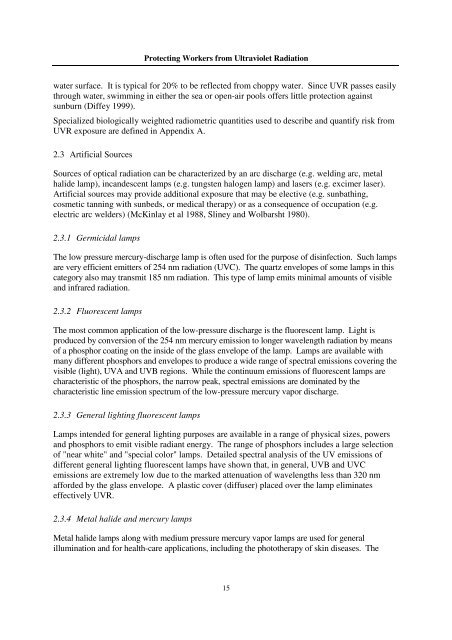Protecting Workers from Ultraviolet Radiation - icnirp
Protecting Workers from Ultraviolet Radiation - icnirp
Protecting Workers from Ultraviolet Radiation - icnirp
Create successful ePaper yourself
Turn your PDF publications into a flip-book with our unique Google optimized e-Paper software.
<strong>Protecting</strong> <strong>Workers</strong> <strong>from</strong> <strong>Ultraviolet</strong> <strong>Radiation</strong><br />
water surface. It is typical for 20% to be reflected <strong>from</strong> choppy water. Since UVR passes easily<br />
through water, swimming in either the sea or open-air pools offers little protection against<br />
sunburn (Diffey 1999).<br />
Specialized biologically weighted radiometric quantities used to describe and quantify risk <strong>from</strong><br />
UVR exposure are defined in Appendix A.<br />
2.3 Artificial Sources<br />
Sources of optical radiation can be characterized by an arc discharge (e.g. welding arc, metal<br />
halide lamp), incandescent lamps (e.g. tungsten halogen lamp) and lasers (e.g. excimer laser).<br />
Artificial sources may provide additional exposure that may be elective (e.g. sunbathing,<br />
cosmetic tanning with sunbeds, or medical therapy) or as a consequence of occupation (e.g.<br />
electric arc welders) (McKinlay et al 1988, Sliney and Wolbarsht 1980).<br />
2.3.1 Germicidal lamps<br />
The low pressure mercury-discharge lamp is often used for the purpose of disinfection. Such lamps<br />
are very efficient emitters of 254 nm radiation (UVC). The quartz envelopes of some lamps in this<br />
category also may transmit 185 nm radiation. This type of lamp emits minimal amounts of visible<br />
and infrared radiation.<br />
2.3.2 Fluorescent lamps<br />
The most common application of the low-pressure discharge is the fluorescent lamp. Light is<br />
produced by conversion of the 254 nm mercury emission to longer wavelength radiation by means<br />
of a phosphor coating on the inside of the glass envelope of the lamp. Lamps are available with<br />
many different phosphors and envelopes to produce a wide range of spectral emissions covering the<br />
visible (light), UVA and UVB regions. While the continuum emissions of fluorescent lamps are<br />
characteristic of the phosphors, the narrow peak, spectral emissions are dominated by the<br />
characteristic line emission spectrum of the low-pressure mercury vapor discharge.<br />
2.3.3 General lighting fluorescent lamps<br />
Lamps intended for general lighting purposes are available in a range of physical sizes, powers<br />
and phosphors to emit visible radiant energy. The range of phosphors includes a large selection<br />
of "near white" and "special color" lamps. Detailed spectral analysis of the UV emissions of<br />
different general lighting fluorescent lamps have shown that, in general, UVB and UVC<br />
emissions are extremely low due to the marked attenuation of wavelengths less than 320 nm<br />
afforded by the glass envelope. A plastic cover (diffuser) placed over the lamp eliminates<br />
effectively UVR.<br />
2.3.4 Metal halide and mercury lamps<br />
Metal halide lamps along with medium pressure mercury vapor lamps are used for general<br />
illumination and for health-care applications, including the phototherapy of skin diseases. The<br />
15



